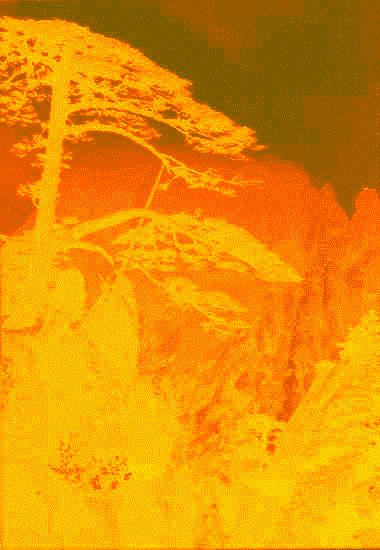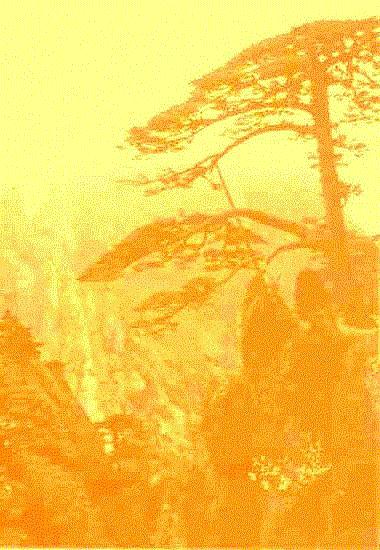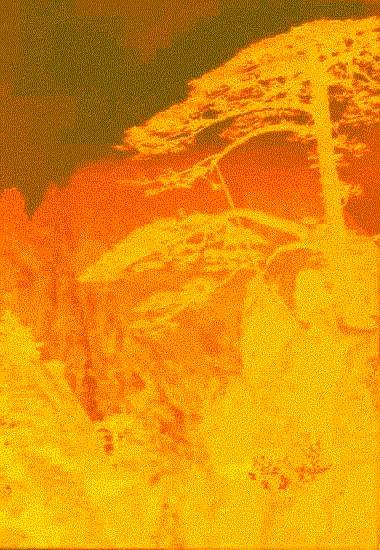



|
and Adaptation via Natural Selection (originally published in the Journal
of the National Museum, Natural History Series)
|
Václav Petr
"Zen is... a unique blend of the philosophies and idiosyncrasies of three different cultures. It is a way of life which is typically Japanese, and yet it reflects the mysticism of India, the Taoists’ love of naturalness and spontaneity and the thorough pragmatism of the Confucian mind."
Consider, for example, the adaptation for camouflage.
Camouflage (generally certain colour patterns) may undoubtedly be of value
to animals in protecting them from their enemies or allowing them to approach
their victims without alarming them (e.g., POULTON 1890, HARTLEY 1948).
Evolutionary biologists are well aware of the existence of different selective
pressures that may create the same characters as well as different characters
that may respond to similar selective forces. Adaptive responses lie behind
many historical explanations of biological structures but what is really
an adaptation via natural selection? The problem generates its own fairly
voluminous literature and the answer of this seemingly straightforward
question is not easy. According to a recent, typically Darwinian book of
Paul H. Harvey and Mark D. Pagel (HARVEY & PAGEL 1998), adaptation
is an inherently comparative idea because when we ask why "white rabbits
are adapted to snowy environments, our answer will inevitably make an implicit
or explicit comparison with rabbits that are not white."
We might answer that white colour provides better camouflage
in the snowy environment than other colours but while adopting a more restricted
meaning of adaptation, the camouflage must be a derived character that
evolved in response to particular selective pressure and the rabbit’s white
coat would be "an adaptation for camouflage (only) if it evolved from
a brown ancestral condition in response to selection for camouflage in
snowy environments." Some authors have pointed out that if it evolved
from a brown ancestor because of "improved thermal properties of the
body, it would not be an adaptation for camouflage but and exaptation for
camouflage" (for the term "exaptation", or "accidental success through
adaptation for other purposes", see the original article by GOULD &
VRBA (1982). Therefore, although "evolution by natural selection can
produce adaptations, the concept of adaptation is not necessarily inherent
in a description of natural selection." (HARVEY & PAGEL 1998).
It is true that natural selection is the common explanation for the rabbit’s white colour. When we in fact discover a rabbit with brown colour, natural selection is again the explanation. To "avoid" the Darwinian circularity of the notion that some variants function better than others and are therefore better adapted (those better adapted survive, and survive those that are better adapted), HARVEY & PAGEL (1998) "need" to explain why some variants function better than others. That accords with the common understanding of adaptation because "white rabbits may leave more offspring than brown rabbits in snowy environments, and the reason why white rabbits leave more offspring is that they live longer than brown rabbits because they are less likely to be detected by predators. The process is specific to a particular environment, so that different variants may be the better adapted in different environments; brown rabbits would be better camouflaged in snow-free woodlands. Evolution by natural selection is also specific to a particular ancestral state: white rabbits must have evolved from something... " It seems to be obvious that the same "ancestral" conditions of natural selection (= selective pressures) are not present in both the white and brown rabbits. And, therefore, "adaptations are produced by natural selection." (HARVEY & PAGEL 1998, p. 14).
"In the struggle for existence better adapted creatures
survive, and survive those that are better adapted" - an obvious Darwinian
circularity. Seemingly, natural selection can account for any result whatsoever.
There seems to be no essential difference between explanations based on
the concept of an all-powerful Creator and that of an all-powerful natural
selection. Both kinds of explanations may fall into the category that could
"neither be proven nor refuted." (see PLATNICK, 1977, 1978). From this
simple point of view, some present-day structuralists and some Gaia-theorists
are led to suspect that all the vast literature on adaptation via natural
selection has no solid foundation. A real solution may flash from Zen philosophy.
What is Zen philosophy? Does it even exist?
It is generally known that the characteristics which distinguish
Zen from other types of Buddhism are problematical because its "truth cannot
be put into words" ("those who know do not speak") and that the awakening
in Zen is something quite natural (using "direct pointing" Zen asserts
that enlightenment manifests itself in everyday affairs) rather than being
almost superhuman as in other schools of Buddhism. But Zen has also a formal
philosophy, originally developed by Fa-tsang (643-712) for the important
school of the Hua-yen Buddhism (or Kegon school) based on the Avatamsaka
Sutra (several prominent patriarchs of the Hua-yen school were simultaneously
Zen masters). According to it, there are four fundamental principles of
existence:
 |
 |
 |
 |
1. Shih, which is a unique, separate thing or event (or "thing-event") in the universe. This is exactly the so-called samsara, or "form" in Buddhism (its equivalent is "matter" in Western philosophy).
2. Li, which means "pattern" or "ultimate reality" underlying the thing-events of the universe. This principle is the so-called nirvana, or "void" of Buddhism (it is "form" in Western philosophy, "transcending principle", or archetype as "ideal form").
3. Li shih wu ai, which is to say that "between pattern and thing-event there is no obstruction (no boundary, no incompatibility)". We can say that pattern (void) is both the goal and the ground of thing-event (form), or even that the void is the form.
4. Shih shih wu ai, meaning that "between
thing-event and thing-event there is no obstruction". In other words, each
"thing-event" involves every other - one of the central images of the Avatamsaka
Sutra is a vast network of gems (like a spider’s web at dawn) in which
each gem reflects all the others. This network of gems is the universe
itself, a realm of innumerable "thing-events" (WATTS 1989).
 |
 |
So, shi denotes the narrow realm of classical Darwinian struggle for existence, li and li shih wu ai represent several sorts of morphogenetic fields of structuralists, while shih shih wu ai depicts Earth as a whole, isolated from its context by Gaia-theorists. Keeping in mind the strictly non-dual Zen philosophy, all these Western scientific attempts to describe reality are nothing but reduction. Zen has great potential as a new paradigm for evolutionary biology and palaeontology. We can see that the fur of blue hares usually turns white in winter, showing that the colour of the body is not a "frozen accident" of the history (frozen by natural selection), and that the organism is not necessarily the helpless puppet of circumstances. The colour of the fur is proportional to temperature and light intensity in the environment. So, the Darwinian duality of organism and environment, subject and object, is just as relative, as mutual, as inseparable as every other. The organism does not become white in the snowy environment because it is cold and because it is better camouflaged. It is just as true to say that the snowy environment is white and cold because the organism is white. The viewpoint is, of course, unfamiliar: it is our settled convention to think that white snow comes first and then, by causality, the white hares. To put it the other way round is unusual, like saying that water is because of the moon. The water seems to be the "subject", and the moon the "object." But the moon-in-the-water phenomenon is similarly "caused" as much by the water as by the moon. For "the moon does not intend to cast its reflection, and the water does not receive its image on purpose" (WATTS 1989). The organism manifests the white colour of the snow, the environment manifests the camouflaged body of the animal. It is ridiculous to talk of the camouflaged body as something which was passively and involuntarily "given" white colour (by natural selection). Simply because before the white camouflaged body there was no body-environment dualism. Moreover, what is "white"? Whiteness, like colour, is strictly subjective, synonymous with the complete absence of any sensation of hue, and like colour it depends as much on the physiological mechanisms as it does on the physical characteristics of the light (WILLMER 1955). It is difficult to distinguish between subjective and objective effects when it is a matter of one's own vision (STILES 1952). The environment, rabbit, and observer arise mutually, they are utterly interdependent and cannot be considered separately from one another.
And what about the rapid adaptive camouflage in tropical flounders? The tropical flatfish Bothus ocellatus can achieve the so-called "pattern-matching" through visual control of melanophores with surprising fidelity, blending well into a wide range of background textures in just 2-8 seconds. Moreover, when pursued around a large tank, the fish would disturb the sand in one location while darting back to bury itself quickly in a different position, thereby deceiving predators into thinking that it was actually buried in the first location (RAMACHANDRAN et al. 1996)). Does such a wonderful behaviour really represent rapid adaptation through natural selection? The problem is that the Darwinian biology enables us to construct symbols of things separately from the things themselves. This includes the ability to make a symbol, an idea of the "organism" separately from the "environment". The symbol, the idea is much more comprehensible than reality, much more stable than the fact. The very usefulness of Darwinian symbols depends upon their stability. The scientists become aware of natural selection as something real but it is only something which connects the symbols. The idea of natural selection becomes more and more rigid but it represents only a deception of symbols pretending to be realities, and to seek after it is "like walking straight into a wall upon which some painter has, by the convention of perspective, suggested an open passage." (WATTS 1989).
Hartley, P. H. T. (1948): Animal camouflage. - Endeavour, 7(27): 97-103. London.
Harvey, P. H. - Pagel, M. D. (1998): The Comparative Method in Evolutionary Biology, 239 pp., Oxford University Press. Oxford, New York, Tokyo.
Platnick, N. I. (1977): Review of: Evolution and the Diversity of Life: Selected Essays, by Ernst Mayr. - Systematic Zoology, 26(2): 224-228. Lawrence.
Platnick, N. I. (1978): Adaptation, selection, and falsifiability. - Systematic Zoology, 27(3): 347-348. Lawrence.
Poulton, E. B. (1890): The colours of animals, their meaning and use, especially considered in the case of insects, 360 pp., The International Scientific Series, vol. 68, Kegan Paul, Trench, Trübner, & Co. Ltd. London.
Ramachandran, V. S. - Tyler, C. W. - Gregory, R. L. - Rogers-Ramachandran, D. - Duensing, S. - Pillsbury, C. - Ramachandran, C. (1996): Rapid adaptive camouflage in tropical flounders. - Nature, 379(6568): 815-818. London.
Stiles, W. S. (1952): Colour vision: a retrospect. - Endeavour, 11(41): 33-40. London.
Watts, A. W. (1989): The Way of Zen, (first publ. in 1957 by Pantheon) 236 pp., Vintage. New York.
Willmer, E. N. (1955): The twelve whites. - Endeavour, 14(53): 19-23. London.
|
|
|
|
|
|
|